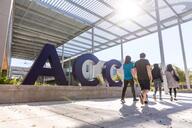You have /5 articles left.
Sign up for a free account or log in.
WASHINGTON -- Colleges and universities face a steep challenge separating fact from fiction in the eyes of working-class and middle-income voters, according to recent focus group work conducted by the American Council on Education.
These groups believe that the economic value of a college education is declining, ACE Senior Vice President Terry W. Hartle told attendees at the group’s annual meeting Monday. One focus group participant believed the average student loan borrower takes on more than $13,000 in debt per year, and a majority of participants said that colleges and universities are indifferent to costs students pay. A majority of participants also said that colleges and universities are for-profit institutions.
Reality is a different story, however. Economists have found that a college degree generally continues to bring significant economic returns, even if some say the wage premium between degree holders and non-degree holders has flattened in recent years. The average borrower who graduated from a four-year college with student loan debt in 2015 carried an average of $30,100 in debt, far below the $52,000 they would owe if they racked up $13,000 per year. A vast majority of colleges and universities in the United States are nonprofit operations.
And while attitudes toward college costs might be a question of perception, many college and university presidents say they are growing increasingly worried about the discussion around college expenses and that they are trying to minimize increases in the overall price tag for students.
Hartle's report on Monday morning set the stage for a discussion with economists Sandy Baum and Anthony P. Carnevale. They tackled the ongoing debate in society over the purpose of higher education -- both economic and noneconomic. It’s a discussion that continues to play out nationally amid concern over student loan debt levels, college costs, opportunity and access for a new generation of students that’s more diverse than its predecessors.
“The conversation that we need to have within higher education on these issues can start this morning,” Hartle said.
Neither Baum nor Carnevale was surprised to see the focus groups reflecting generally negative ideas about the state of higher education. People tend to focus on negative stories that play into their fears when they feel stressed about an issue, said Carnevale, who is a research professor and director of the Georgetown University Center on Education and the Workforce.
The public knows the best shot at a middle-class lifestyle is a college education, he said. But the fear of falling or failing is enormous.
“I think the bad news indicates the public sees this as an area in which there is difficulty and significant risk in their lives, and they want something done about it,” he said.
Baum, who is a senior fellow at the Urban Institute, made the case that the issue of student loan debt is much more complex than it seems on the surface. Those who borrow more than $50,000 have typically gone to graduate or professional school, so they end up making higher wages that subsequently help them pay back higher debt burdens, she said. On the other hand, those who struggle the most to pay back their debts are those who borrowed small amounts of money to attended college but dropped out before finishing their degrees.
The best predictor of ability to repay student loans is whether a student has completed college, Baum said. She said the default rate for those who completed a college degree or certificate is 9 percent. It is 24 percent among those who dropped out without any credential. That’s a different picture than the overall 14 percent default rate.
Still, Baum cautioned against overselling the wage benefits of an education. Statistics showing higher wages for those with degrees are not a hard-and-fast rule applying to every graduate. Some people with bachelor’s degrees end up earning less than peers with high school degrees if you compare different fields and different situations.
“If we’re going to convince people of the value of a college education, I think we have to up front address the fact that it doesn’t work out for everyone,” Baum said. “There is a wide range of earnings within levels of higher education attainment.”
There is also a difference between a student who wants to maximize lifetime earnings and one who wants to make sure they earn enough to stay in the middle class while still pursuing a career that they find personally fulfilling. Baum gave educators as an example of workers who typically need a college degree but could be earning more elsewhere.
“They certainly want to live well,” she said. “But they know they could do something different and make more money. And as a society, we are going to lose a lot if we measure all of college success in terms of postcollege earnings.”
Institutions have to be able to talk through the complex choices students and families must make, Baum said. They might need to caution students who might not be making the best choices for their particular situation.
She added that not everyone wants to go to college. Those who want to have a good job without having to first sit in a classroom have a dearth of good opportunities. The public is being pushed toward college because society has not figured out good options for those who don’t want to go to college. Some end up not being successful in college and resenting the fact they were directed to take out student loans and head to campus.
Simply throwing information at prospective students won’t help. “We need to help people make better choices,” Baum said. “They need much more guidance and advice from us, and that may not always be the guidance that is going to help your immediate enrollment or bottom line.”
Trying to market higher education or tell a better story about it isn’t a solution, Carnevale said.
“I don’t think higher education has a marketing problem,” he said. “I think the numbers now are 70 to 80 percent of kids try to go to college. That’s pretty good. If 70 to 80 percent of people bought a Hershey bar every day, Hershey wouldn’t be worried about marketing. I think it’s a deeper set of questions.”
He called on the higher education system to become more efficient in delivering learning and focusing on career outcomes. Almost every other industry has used network systems with outcome-based standards since the 1980s, he said.
He also argued that there is a difference between jobs and careers. Young workers go through a long period in which they develop work experience and on-the-job skills, he said. They can successfully do that by moving from job to job in the same field. But if they change fields -- and change careers -- they’re likely to take a major income hit.
That means looking at college outcomes in a different way. Students can’t necessarily predict a career path ending at a specific job. But they can find jobs out of college that help them build a skill set and a career.
“The real issue gets to be in education not what you’re eventually going to do,” Carnevale said. “It’s what’s your first job going to be. Because that’s what starts that process.”




